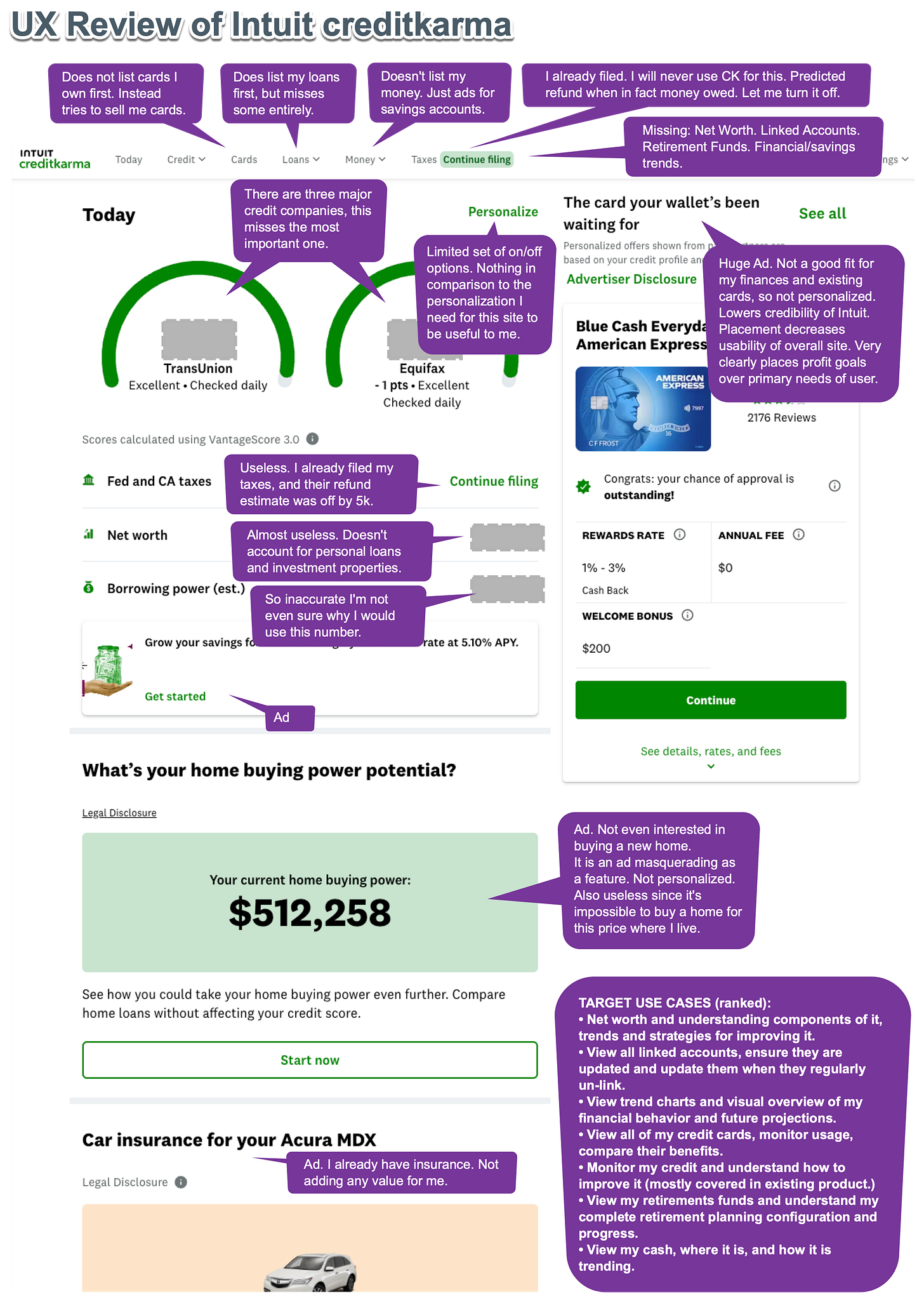AI-UX: Generative Intent-Based Product Interfaces
Save us from the PMs and UX designers who ignore primary use cases and purposefully disempower users. AI may yet save the day with generative interfaces that focus on your goals.
As an example of the problem we are facing, take a look at Intuit Creditkarma, which purports to help you manage your credit and personal finances.
Creditkarma seems to rejoice in its desire to advertise things that don’t make sense for you, show you inaccurate predictions about things you don’t care about, and ignore most of your primary goals for this type of service. Empowerment means that the user can do what they need to do. Disempowerment is not giving them the control and tools needed to get there.
This site is not alone. Many everyday products and services from home automation tools to shopping platforms do not focus on the primary tasks that matter to the individual user (and perhaps even their average user.) One might argue that their PMs and design teams don’t even know what the primary goals of the users are, or have lost their focus as new features were added. Two examples from the Alexa and Amazon apps are shown below, where primary task flows for certain user types are being ignored.

How Can AI Help?
Unlike most interfaces, AIs (LLMs) ask you what you want first. Then they do their best to get you to your goal. It is literally structuring the entire interface and workflow to empower the user to achieve their goals. Compare that model to the examples shown above.
In medicene, each person needs something a little different because they are individuals. For example, you would probably prefer to receive a drug or diet program specifically designed for your genetic profile, health history, and preferences. If it was designed for the “average person” it might not work well for you. Just like we need personalized medicene, we also need personalized interfaces. If you have disabilities, or preferences, or simplify personal goals - those should factor into the UI you see, and the underlying UX workflows. Nobody else wants to use your interface, and you don’t want to use theirs.
Early computers were centralized unix mainframes that required all users to adapt to the constraints of the server. Now the tables have been flipped and the central server (or maybe de-centralized or local server in the future) will be creating a completely custom interaction paradigm for each individual user. Generative AI is personalization on steroids - it literally focuses only on what you are asking and the answer you need. However, gen-AI has yet to translate this paradigm into a GUI. Once this gap has been filled, users will be able to build their own reusable custom interfaces using speech, in ways that previously required tedious programming.
Nielsen Norman Group has been hitting it out of the park recently with a set of articles exploring the topic of “intent-based” interfaces, and the role UX designers will play in crafting “gen-ui” interaction patterns and template systems for AIs to use when producing custom interfaces. Generative UI and Outcome-Oriented Design | Paradigm 3: Intent-Based Outcome Specification
Envisioning a Gen-UX Interface for a Personal Finance App
As a comparison to what current personal finance apps are doing, imagine what a truly customized AI interface that empowered users would look like:
“Show me an overview of my net worth and which types are increasing the fastest.”
“Show me a comparison of my credit cards and the relative benefits of each.”
“Show me how much my loans are costing me each month.”
“Go add this loan that I have, but that you are missing currently.”
“Show me a chart of whether I’m net-positive or negative in terms of income and expenditures each month for the last year.”
“Create a dashboard summarizing all of my previous requests so I can monitor it on one screen with suitable visuals.”
“Remember all of this the next time I log in, and send me alerts if you see any large changes in the items I’ve shown an interest in here.”
The above interaction scenario will not be sci-fi for long.
Disclaimer: None of my design articles directly relate to current or past employers, or products I have worked on. I have a Ph.D. in Interaction Design and 20+ years of UX experience. This does not necessarily mean I am right about everything. Use your own judgement, and I hope you have found my observations on UX topics thought-provoking and useful for your own work.


